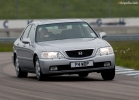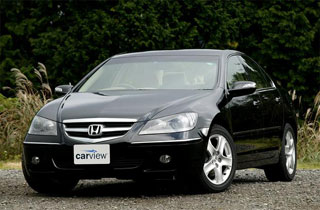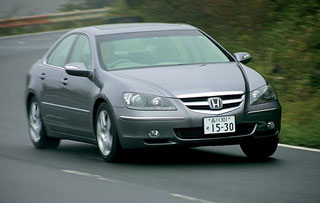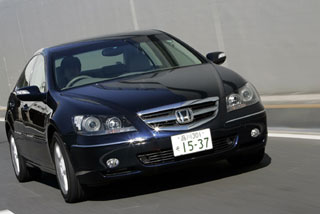Test drive Honda Legend sedan 1996 - 2005 sedan
Diamonds from the legend
In the world of cars, as in the world of people, there are legends and myths. The Japanese encroached on one of them, releasing Mitsubishi Diamante and Honda Legend in the mid-90sthe second mobile class must have a classic layout, that is, rear -wheel drive. We think that at the end of the twentieth century, such statements are deprived of sufficient grounds. Such myths are beneficial only to those who have mastered a certain niche in the automotive market and are trying to protect it from competitors in all ways and methods. Recognized authorities in the production of full -sized sedans of the highest class began to be attacked from the country of the rising sun. The beginning was laid in the United States, in the market in the first half of the 90s, luxury versions of Toyota, Nissanov and Chond rolled out under the brands Lexus, Infiniti and Acura. The pen test was successful, and it seems that a new stage of creeping aggression of the Japanese has gone. Full -size sedans of the highest class with front -wheel drive began to master new markets. These cars could be classified as borderline between the middle and luxury class. And here, in terms of sales, the Japanese achieved obvious success.
Classical cut. Despite the fact that both of these cars belong to the same class, there is no need to talk about external similarities. The classic Legend contours contrast with the predatory appearance of Diamante. The begged corners of the front part with narrow headlights integrated in them, a smooth hood and a gentle windshield partly give Diamante a similarity with a sports compartment. Add here the roof close to the hemisphere and the absence of the framework of the door glasses will be almost complete.
Legend is a little more conservative. But in the old -fashionedness it is impossible to blame him. External conservatism gives it the element of solidity that Diamante is slightly lacking.
The leather interior of both machines is decorated with inserts that simulate a nut tree. In Legend decoration, the creators somewhat stinted on this material, in Diamante it is represented much more generously. But still, Honda quality, perhaps, will be higher. The nut seemed more natural to us, although perhaps this opinion is subjective
The difference in the length of the base and external dimensions in favor of Legend. From this point of view, Honda is more oriented towards the rear seat passenger. For him, a huge armrest with boxing for little things and, of course, a double cup holder. Although they also did not forget about the driver: the upper part of the central console between the seats lifts the centimeter to four excellent supports for the right elbow on the long journey.
Many of the consumers of representative cars are not inclined to be original and prefer classic forms. Here, on them, and above all in the Old World, and a third generation Legend aimed. And Diamante is still delivered to the North American market, and there, as you know, the tastes are somewhat different.
The situation obliges. A car of this class is inconceivable without a specific gentleman's set. Cruise control, leather, climate control with a filter of outboard air and two modes, heating seats, heating of external mirrors, a two-position hatch, a full electrical package, a built-in Bose or Infinity audio system with CD and eight speakers ... All this, as it were, of course .
The standard Legend set, among other things, includes an electric drive of a two -position adjustment of the steering column. The passenger seat is also equipped with an electric drive. There is a memory for the two provisions of the driver's seat and steering wheel, and when the ignition is turned off, the steering wheel moves away from the driver, facilitating the exit. Previously, this was found only in Jaguar or 140th body. And in 1999, an automatically obscured intra -sulfate mirror and now -fashioned now xenon headlights will be added.
Diamante has a slightly different environment. There is the same auto -to -wash mirror, but only a driver's seat is equipped with electrical adjustments and memory, the steering column is regulated mechanically and only in a vertical plane. But on the other hand, a triple-computer was discovered, informing information about the run, the supply of fuel, its average consumption and medium speed.
And Diamante also has useful, probably, someone is a thing: this is the so-called Home Link System. With the help of a device mounted in the ceiling above the mirror, you can, without leaving the car, open the gates of your villa, include light in it, etc. So if you have it all, feel free to get Diamante ... But if there is also a numerous servant who will perform all the above actions then you can already pay attention to Legend.
Diamonds forever. The engines that are equipped with Legend and Diamante are similar as twin brothers. The difference of about five horses on the road is completely imperceptible. The designers who created Legend made a little power, but won the torque. This motor gives its maximum value at the record -low speed for this type of engine only 2800. Honda engineers managed to achieve such results by applying the principle of variable geometry of the intake manifold on this motor.
Diamante is equipped with us by Mitsubishi Pajero with a 3.5-liter 6G74 engine. In terms of characteristics, it is almost similar to Honda. Balanced, almost silent and very reliable. The maximum torque falls at 3000 rpm. Is the difference great?
Honda is famous for its engines, and the Legend engine is not an exception to the rule. Of the existing analogues, it is recognized as one of the most quiet and balanced engines. Absolutely no noise and vibrations whether it works or not, from the passenger compartment can only be determined by the tachometer.
Powerful, confident, but at the same time, the soft dynamics of Legend gives real pleasure. With its dimensions, the car is easily controlled, has excellent maneuverability. The suspension, as befits the class, is very comfortable, but still there is a pleasant sports highlight in it. The real nature of Legend is manifested at high speed on the highway, and the higher the speed, the more distinct the features of a comfortable limousine, confidently and firmly standing on the road.
Legend is equipped only by automatic transmission with the adaptation system to the GRADE LOGIC CONTROL road conditions. When dumping gas, it provides braking with an engine, and also maintains a stable speed of the car, switching to the transfer below or higher. A sort of simplified version of the cruise control. After all, the road environment is not always allowed to include it. And yet this machine gun was a little disappointed. No, there is no question of the notorious thoughtfulness, but some inertiality is present, especially in the Kik-Daun mode. Which, however, is partly compensated by the device of the box, which allows you to accelerate in manual switching mode from the second to the fourth gear and vice versa, help with engine braking.
Such tricks do not pass with Diamante. It establishes a unique development of Mitsubishi adaptive GPP InVecs-II, the essence of which in the ability to adapt to the driving style. Purely subjectively, the impression remained that the Diamante checkpoint works a little more vigorously. But this difference is difficult to catch.
In general, in behavior it is closer to typical American asphalt battleships. This does not mean that the steering wheel is listening worse, keeps the road or something like that. It’s just that his reactions are somewhat different, which is due to a completely different suspension scheme and, in all likelihood, setting it for American tastes. Although the controllability, exchange rate stability and tenacity with which Diamante holds to the road deserves all praise, some excessive imposition is observed.
In any case, both cars can equally be able to enjoy both those who prefer to hold the steering wheel in their hands on their own, and the one who is more attracted by the passive role of the passenger.
Text Andrey Timofeev, photo Alexey Ilyin
Source: "Autopilot"







